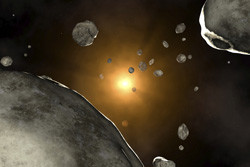Primitive magnetic attraction
Indeed, magnetic fields could have played a major role in the rotation and gradual collapse of the nebula from which the primary components of our solar system were generated. In particular, internal fields generated by a dynamo within solid objects provide information on the parent body evolution. EU-funded scientists studied meteorite samples from planetesimals that served as building blocks for planets. The EXTRAMAG study covered several groups of meteorites, including carbonaceous chondrites that are believed to have formed at a greater distances than ordinary chondrites. As such, more than being a different chondrite group, they offered the possibility to estimate the magnetic field's strength in an unknown part of the early solar system. A detailed palaeomagnetic study aimed to explore the nature and origin of magnetic fields recorded in these meteorites that have experienced little differentiation. Scientists found that the parent body of carbonaceous chondrites was surrounded by magnetic fields generated by a dynamo deep inside its solid core. Nonetheless, other groups of meteorites did not carry remnant magnetisation. Magnetism found in lunar rocks scooped up by astronauts during the Apollo mission suggest that the Moon long sustained a dynamo, much like Earth's that produces a global magnetic field. Analysis of samples brought back to Earth helped scientists to track the entire history of the lunar magnetic fields. The age of more than 100 rocks implied that the dynamo was still operating some 3.2 billion years ago. The small core was expected to have cooled off quickly and the dynamo-generated magnetic field to have disappeared earlier than 800 hundred million years after the Moon's formation. Researchers had to explore alternative scenarios for how the dynamo could be sustained. The EXTRAMAG study suggests that a mechanism different to the Earth-like dynamo existed. Despite the exciting findings of the EXTRAMAG project, many questions about the Moon's magnetic field await an answer. For example, how it disappeared over time. Learning how the Moon's dynamo developed could also yield insights into the dynamos of other planets as well as smaller objects, such as asteroids. The Moon is like a laboratory where theories about how planets evolved can be tested.




